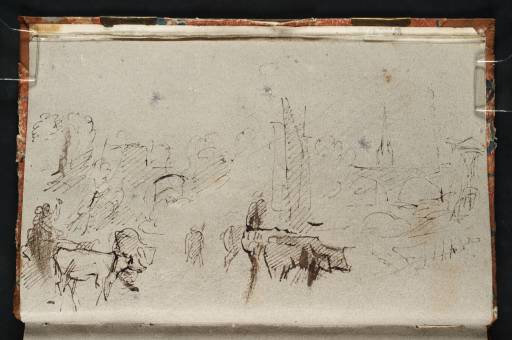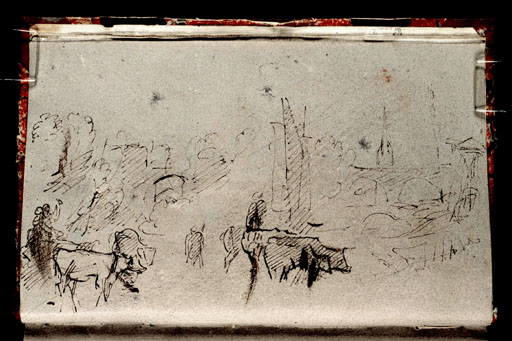Joseph Mallord William Turner Study for 'Abingdon' 1805
Image 1 of 2
Joseph Mallord William Turner,
Study for 'Abingdon'
1805
Joseph Mallord William Turner 1775–1851
Folio 4 Verso:
Study for ‘Abingdon’ 1805
D05850
Turner Bequest XCIV 4a
Turner Bequest XCIV 4a
Pen and ink and brownish wash on white wove paper, prepared with a grey wash, 143 x 228 mm
Accepted by the nation as part of the Turner Bequest 1856
Exhibition history
1998
Turner and the Scientists, Tate Gallery, London, March–June 1998 (44).
References
1909
A.J. Finberg, A Complete Inventory of the Drawings of the Turner Bequest, London 1909, vol.I, p.244, XCIV 4a, as ‘Study for “Abingdon”’.
1974
Gerald Wilkinson, The Sketches of Turner, R.A. 1802–20: Genius of the Romantic, London 1974, pp.73, 74 reproduced in colour.
1977
Gerald Wilkinson, Turner Sketches 1789–1820, London 1977, pp.11, 109 reproduced (as folio 40 verso).
1982
Evelyn Joll and Martin Butlin, L’opera completa di Turner 1793–1829, Milan 1982, p.97.
1984
Martin Butlin and Evelyn Joll, The Paintings of J.M.W. Turner, revised ed., New Haven and London 1984, p.77.
1993
David Hill, Turner on the Thames: River Journeys in the Year 1805, New Haven and London 1993, pp.138, 166, as ‘Abingdon, Oxfordshire’.
2004
Kasper Monrad, David Blayney Brown, Anne Lyles and others, Turner and Romantic Nature, exhibition catalogue, Statens Museum for Kunst, Copenhagen 2004, p.29 reproduced in colour fig.1.
This drawing of Abingdon served as the basis of the picture (Tate N00485) formerly known as ‘Dorchester Mead, Oxfordshire’ having been identified with the work exhibited under that title at Turner’s Gallery in 1810 although it was titled ‘Abingdon, taken from the River’ when sold in 1829 from the collection of its first owner, George Hibbert.1 Hill, recognising another picture (Tate N00462)2 as the 1810 exhibit, plausibly argues that Abingdon was shown at Turner’s Gallery in 1806 or 1807, years for which there are no complete lists of exhibits. The view is of the Thames, which here splits into two channels, with Abingdon Bridge, the adjacent Nag’s Head Inn and, beyond the bridge in the right distance, the spire of St Helen’s Church. A slighter outline of the same view but from closer to the bridge, is on folio 40 verso of the sketchbook (D05899). Both sketches were presumably made from nature.
Here, the main elements of the picture are already in place, including two groups of cattle in the foreground and a boat at the centre. In Wilkinson’s opinion the ‘misty-morning effect of this picture owes nothing to the sketch’,3 but in fact the interplay of firm and light pressure on the pen and the use of hatching foreshadow the tonal variations of the oil and the way in which its features dissolve into luminous vapour. For the right of the picture, Turner seems to have borrowed the motif of a crane from his adjoining sketch on folio 5 (D05851), made near Walton Bridge; it is shown unloading timber, as Hill suggests for the construction of Abingdon’s new gaol being built beyond the bridge at this period.4 Turner also made, probably in the studio, two small variant composition studies for the picture on a single leaf of the Hesperides (1) sketchbook (Tate D05799; Turner Bequest XCIII 21a).
David Blayney Brown
December 2007
Butlin and Joll 1984, p.77 no.107 (pl.114); the confusion over the title of this picture is discussed by the authors who identify it with the 1810 ‘Dorchester Mead’.
How to cite
David Blayney Brown, ‘Study for ‘Abingdon’ 1805 by Joseph Mallord William Turner’, catalogue entry, December 2007, in David Blayney Brown (ed.), J.M.W. Turner: Sketchbooks, Drawings and Watercolours, Tate Research Publication, December 2012, https://www


